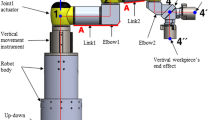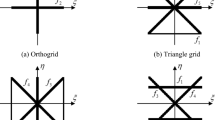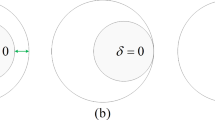Abstract
This paper proposes a new 2R1T PRS-PRU-PUR overconstrained parallel mechanism (PM). Firstly, the kinematics and stiffness are studied based on screw theory and strain energy. Compared with a typical 3-PRS PM, the main advantage of the proposed PRS-PRU-PUR PM is that the orientational range β is improved by 50 %. Secondly, the original PM’s kinematic and stiffness performance are evaluated by using the global transmission index and stiffness index, which are 0.675 and 594 respectively, which causes the decrease of the efficiency of some configurations. Finally, the design parameters are optimized to enhance the PM’s kinematic and stiffness performance. The corresponding optimized indices were increased to 0.915 and 2171, respectively, confirming the validity of the optimal design method.
Similar content being viewed by others
Abbreviations
- PM :
-
Parallel mechanism
- 2R1T :
-
Two rotations and one translation
- DOF :
-
Degrees of freedom
- P :
-
Prismatic joint
- R :
-
Revolute joint
- S :
-
Spherical joint
- U :
-
Universal joint
- O-xyz :
-
Fixed coordinate frame
- O′-x′y′z′ :
-
Moving coordinate frame
- $ ij :
-
The jth unit screw
- \(\$_{ij}^r\) :
-
The jth wrench for unit constraint
- $ Ci :
-
The ith unit constraint wrench of the PM
- \(\$_i^{pm}\) :
-
The ith unit twist for the moving platform
- α :
-
The rotational angle around the x-axis
- β :
-
The rotational angle around the y′-axis
- s :
-
Sine function
- c :
-
Cosine function
- z o :
-
The operational height of the moving platform
- q i :
-
The ith actuated variable of the P joint
- R′ :
-
Rotation matrix
- R x}:
-
Rotation matrix around the direction of x-axis
- R y′ :
-
Rotation matrix around the direction of y′-axis
- p :
-
Position vector of origin O′
- c i}:
-
Position vector of AiBi
- Γ :
-
Local transmission index (LTI)
- $ Ai :
-
The input twist screw (ITS) of the ith limb
- $ Tj :
-
The transmission wrench screw (TWS)
- $ Oi :
-
The output twist screw (OTS) of the ith limb
- λ i :
-
The input transmissibility of the ith limb
- η i :
-
The output transmissibility of the ith limb
- GTW :
-
Great transmission workspace
- σ :
-
Global transmission index (GTI)
- S g :
-
GTW areas
- S :
-
Areas of overall workspace
- E :
-
Elastic modulus
- G :
-
Shear modulus
- A :
-
Area of cross section
- I ly :
-
Moment of inertia in the y-axis area
- J l :
-
Polar inertia moment
- K :
-
Matrix of the overall stiffness
- C :
-
Matrix of the overall flexibility
- W :
-
Applied external wrench
- f ij :
-
Constraint force
- m ij :
-
Constraint moment
- κ :
-
Virtual-work stiffness index (VSI)
- ς :
-
Global stiffness index (GSI)
- B i-x i y i z i :
-
Limb coordinate frame
References
R. Clavel, A fast robot with parallel geometry, Proceedings of the 18th International Symposium on Industrial Robots, Lausanne, Switzerland (1988) 91–100.
L. M. Xu, Q. H. Chen, L. Y. He and Q. C. Li, Kinematic analysis and design of a novel 3T1R 2-(PRR)2RH hybrid manipulator, Mech. Mach. Theory., 112 (2017) 105–122.
X. Luo, F. G. Xie, X. J. Liu and Z. H. Xie, Kinematic calibration of a 5-axis parallel machining robot based on dimensionless error mapping matrix, Robot. Comput. Integr. Manuf., 70 (2021) 102115.
A. K. Inkulu, M. R. Bahubalendruni, A. Dara and K. Sankarana-rayanaSamy, Challenges and opportunities in human robot collaboration context of Industry 4.0-a state of the art review, Industrial Robot, 49 (2) (2022) 226–239.
J. Wahl, Articulated Tool Head, WO/2000/025976, WIPO Patent (2002).
Z. M. Bi and Y. Jin, Kinematic modeling of exechon parallel kinematic machine, Robot. Comput. Integr. Manuf., 27 (1) (2011) 186–193.
B. Siciliano, The Tricept robot: Inverse kinematics, manipulability analysis and closed-loop direct kinematics algorithm, Robotica, 17 (4) (1999) 437–445.
Q. C. Li and J. M. Hervé, Type synthesis of 3-DOF RPR-equivalent parallel mechanisms, IEEE Transactions on Robotics, 30 (6) (2014) 1333–1343.
L. M. Xu, X. X. Chai, Q. C. Li, L. A. Zhang and W. Ye, Design and experimental investigation of a new 2R1T overconstrained parallel kinematic machine with actuation redundancy, ASME Journal of Mechanisms and Robotics, 11 (3) (2019) 031016.
Z. Chen, Z. M. Chen, Y. W. Li and Z. Huang, Motion characteristics analysis of a novel 2R1T 3-UPU parallel mechanism, ASME J. Mech. Des., 142 (2) (2020) 012302.
Starrag Group, Ecospeed Series, Starrag Group, https://www.starrag.com/zh-cn/series/ecospeed-ecoliner-xi-lie/27/product-range/11, Accessed on June 17 (2021).
Exechon World, Structure Concept of Exechon PKM, Exechon World, http://www.exechonworld.com/document/200804/article34.htm, Accessed on February 10 (2021).
B. B. V. L. Deepak, C. A. Rao and B. M. V. A. Raju, Kinematic Modeling and Simulation of Manipulator for Executing Welding Operations with Arbitrary Weld Joint Profiles, Springer India (2016).
B. B. V. L. Deepak, C. A. Rao and B. M. V. A. Raju, Weld Seam Tracking and Simulation of 3-Axis Robotic Arm for Performing Welding Operation in CAD Environment, Springer India (2016).
S. Zarkandi, Kinematic analysis and optimal design of a novel 3-PRR spherical parallel manipulator, Proceedings of the Institution of Mechanical Engineers, Part C: Journal of Mechanical Engineering Science, 235 (4) (2021) 693–712.
H. Shen, Y. Zhao and G. Wu, Kinematic design of a translational parallel mechanism based on sub-kinematic chain determined workspace superposition, Proceedings of the Institution of Mechanical Engineers, Part C: Journal of Mechanical Engineering Science, 235 (24) (2021).
R. S. Stoughton and T. Arai, A modified stewart platform manipulator with improved dexterity, IEEE Trans. Robot. Autom., 9 (2) (1993) 166–173.
Y. J. Wang, B. Belzile, J. Angeles and Q. C. Li, Kinematic analysis and optimum design of a novel 2PUR-2RPU parallel robot, Mech. Mach. Theory, 139 (2019) 407–423.
J. P. Merlet, Jacobian, manipulability, condition number, and accuracy of parallel robots, ASME J. Mech. Des., 128 (1) (2006) 199–206.
B. Siciliano and O. Khatib, Handbook of Robotics, Springer, Berlin, Heidelberg (2008).
B. S. El-Khasawneh and P. M. Ferreira, Computation of stiffness and stiffness bounds for parallel link manipulators, Int. J. Mach. Tool. Manuf., 39 (2) (1999) 321–342.
A. Klimchik, A. Pashkevich and D. Chablat, CAD-based approach for identification of elasto-static parameters of robotic manipulators, Finite. Elem. Anal. Des., 75 (6) (2013) 19–30.
C. Gosselin, Stiffness mapping for parallel manipulators, IEEE Trans. Robot. Autom., 6 (3) (1990) 377–382.
T. Sun, B. B. Lian and Y. M. Song, Stiffness analysis of a 2-DoF over-constrained RPM with an articulated traveling platform, Mech. Mach. Theory, 96 (2016) 165–178.
A. Pashkevich, D. Chablat and P. Wenger, Stiffness analysis of overconstrained parallel manipulators, Mech. Mach. Theory., 44 (2009) 966–982.
G. D. L. Soares Júnior, J. C. M. Carvalho and R. S. Goncalves, Stiffness analysis of multibody systems using matrix structural analysis—MSA, Robotica, 34 (10) (2016) 2368–2385.
X. Shan and G. Cheng, Static analysis on a 2(3PUS+S) parallel manipulator with two moving platforms, Journal of Mechanical Science and Technology, 32 (8) (2018) 3869–3876.
E. Courteille, D. Deblaise and P. Maurine, Design optimization of a delta-like parallel robot through global stiffness performance evaluation, Proceedings of 2009 IEEE/RSJ International Conference on Intelligent Robots and Systems, Missouri, USA (2009) 5159–5166.
Q. S. Xu and Y. M. Li, GA-based architecture optimization of a 3-PUU parallel manipulator for stiffness performance, Proceedings of the IEEE 6th World Congress on Intelligent Control and Automation, Dalian, China (2006) 9099–9103.
G. Carbone and M. Ceccarelli, Comparison of indices for stiffness performance evaluation, Front. Mech. Eng., 5 (3) (2010) 270–278.
J. S. Wang, C. Wu and X. J. Liu, Performance evaluation of parallel manipulators: motion/force transmissibility and its index, Mech. Mach. Theory, 45 (10) (2010) 1462–1476.
F. G. Xie, X. J. Liu and J. S. Wang, A 3-DOF parallel manufacturing module and its kinematic optimization, Robot. Comput. Integr. Manuf., 28 (3) (2012) 334–343.
L. M. Xu, Q. C. Li, J. H. Tong and Q. H. Chen, Tex3: An 2R1T parallel manipulator with minimum DOF of joints and fixed linear actuators, Int. J. Precis. Eng. Man., 19 (2) (2018) 227–238.
S. J. Yan, S. K. Ong and A. Y. C. Nee, Stiffness analysis of parallelogram-type parallel manipulators using a strain energy method, Robot. Comput. Integr. Manuf., 37 (2016) 334–343.
Z. Huang and Q. C. Li, Type synthesis of symmetrical lower-mobility parallel mechanisms using the constraint-synthesis method, Int. J. Rob. Res., 22 (1) (2003) 59–79.
C. Yang, Q. C. Li and Q. H. Chen, Elastostatic stiffness modeling of overconstrained parallel manipulators, Mechanism and Machine Theory (12) (2018) 58–74.
B. Hu, H. Cui and D. Shi, Reachable workspace determination for a spatial hyper-redundant manipulator formed by several parallel manipulators, Journal of Mechanical Science and Technology, 33 (2) (2019) 869–877.
Acknowledgements
This research work was supported by the National Natural Science Foundation of China under Grant 51935010 and the Fundamental Research Funds of Zhejiang Sci-Tech University under Grant 23242135-Y.
Author information
Authors and Affiliations
Corresponding author
Additional information
Zhen Wu received a B.S. degree in ship and ocean engineering from Zhejiang Ocean University, Zhoushan, China in 2013 and received an M.S. degree in ship and ocean engineering from Wuhan University of Technology, Wuhan, China in 2016. He is currently pursuing a Ph.D. degree with the School of Mechanical Engineering, Zhejiang Sci-Tech University. His main research interests are theoretical analysis of parallel robots.
Xinxue Chai received B.S. and Ph.D. degrees in mechanical engineering from Zhejiang Sci-Tech University, Hangzhou, China in 2011 and 2017, respectively. Since 2017, she has been a lecturer with the School of Mechanical Engineering, Zhejiang Sci-Tech University. Her research interest includes mechanism theory using geometric algebra.
Wei Ye received B.S., and Ph.D. degrees in mechanical engineering from Beijing Jiaotong University, Beijing, China, in 2010 and 2016, respectively. He joined the School of Mechanical Engineering, Zhejiang Sci-Tech University, in 2016, where he is currently an Associate Professor. He is the author of one book and more than 20 articles. His research interests include mechanism theory of parallel manipulators and application.
Rights and permissions
About this article
Cite this article
Wu, Z., Chai, X. & Ye, W. Kinematic and stiffness modelling and performance evaluation of a new PRS-PRU-PUR overconstrained parallel mechanism. J Mech Sci Technol 37, 5377–5389 (2023). https://doi.org/10.1007/s12206-023-0938-z
Received:
Revised:
Accepted:
Published:
Issue Date:
DOI: https://doi.org/10.1007/s12206-023-0938-z




